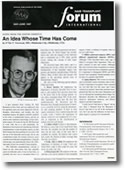by O’Tar T. Norwood, MD, Oklahoma City, Oklahoma, USA
Hair Transplant Forum International (May/June 1997 issue)
 I just returned from visiting Dr. Bob Bernstein in New York, and was impressed with his operation and even more impressed with his thoughts, observations, and insights into hair transplant surgery. He applies scientific methods to his work, is academically honest, and has an almost eerie instinctive knowledge of hair transplant surgery. Of course he has Dr. Bill Rassman to work with, but it is still remarkable. Dr. Bernstein is best known for introducing follicular transplantation ((R. Bernstein and W. Rassman Follicular Transplantation, International Journal of Aesthetic and Restoration Surgery. Vol. 3: No 2,1995, 119-132.)) to hair transplant surgery, an idea Bob Limmer has been pushing for ten years with the use of the binocular microscope, but no one would listen to him. Dr. Limmer, however, never used the term follicular transplantation. Using the microscope, you automatically dissect the follicular units. It can’t be avoided if done properly.
I just returned from visiting Dr. Bob Bernstein in New York, and was impressed with his operation and even more impressed with his thoughts, observations, and insights into hair transplant surgery. He applies scientific methods to his work, is academically honest, and has an almost eerie instinctive knowledge of hair transplant surgery. Of course he has Dr. Bill Rassman to work with, but it is still remarkable. Dr. Bernstein is best known for introducing follicular transplantation ((R. Bernstein and W. Rassman Follicular Transplantation, International Journal of Aesthetic and Restoration Surgery. Vol. 3: No 2,1995, 119-132.)) to hair transplant surgery, an idea Bob Limmer has been pushing for ten years with the use of the binocular microscope, but no one would listen to him. Dr. Limmer, however, never used the term follicular transplantation. Using the microscope, you automatically dissect the follicular units. It can’t be avoided if done properly.
The follicular transplantation concept is based on the observation that hair naturally grows in follicular units of one to four hairs, so probably the best way to transplant them is to keep them in this natural anatomical and physiological state. Dr. David Seager ((DJ Seager, Micrograft Size and Subsequent Survival, accepted for publication, Dermatologic Surgery.)) has recently shown that when the integrity of the follicular unit is maintained up to 20%, better growth occurs, making this concept of truly major importance.
We discussed many other topics, and it is interesting how he has a fresh, new look at the fundamentals of hair transplant surgery, hair growth, and anatomy and physiology of the hair follicle. Many of these ideas and concepts will appear in the upcoming special issue of Dermatologic Surgery. ((R. Bernstein and W. Rassman, The Art of Follicular Transplantation, accepted for publication, Dermatologic Surgery.))
His views on the following special subjects I find interesting:
1. Donor density: He emphasizes the importance of density, describes how to measure it, and explains how precious donor hair is. He shows that in the average patient, we can safely transplant about 50% of the available “permanent” donor hair. He does this mathematically. Dr. Bernstein and Dr. Rassman have brought measurement of density to a scientific level by using the densitometer and counting numbers of hairs in each square centimeter. I have started using this and it really works. I believe the importance of density cannot be over-emphasized. It is actually as important as the classification in patient selection and design.
2. Caliber of hair: Coarse vs. fine diameter. He believes coarse hair covers much better than fine hair. He considers not only the number of hairs but the total value of hair mass that is available for transfer. He believes that coarse hair creates the illusion of fuller coverage than fine hair can achieve.
3. Scalp – thin vs. thick: He emphasizes the importance of thickness of scalp. I have preferred thick scalps to thin scalps for years, but never was quite sure why.
4. Delayed growth: His analysis of the natural hair cycle and its relation to hair transplant surgery, I think, is brilliant. It explains what we see on a daily basis. ((R. Bernstein and W. Rassman, Delayed Hair Growth, Hair Transplant Forum International. Vol. 7: No 3, 1997.))
5. Diffuse patterned alopecia (DPA) and diffused unpatterned alopecia (DUPA):
Although I first described these years ago, I failed to recognize their importance. They are quite common in men and women. Although they have received some recognition in women, their study in men has been completely ignored. It is important to distinguish DUPA and DPA because hair transplants should probably never be done on a patient with DUPA.
6. Aging alopecia: This occurs in everyone and occasionally occurs extremely early in life, so that is important to recognize. I have watched my own hair thin over the years, and I have watched my patients’ donor hair and their transplanted hair thin over the years. Sometimes you can see through the remaining donor fringe. Dr. Bernstein describes the differences of senile alopecia, androgenic alopecia, and diffuse alopecia and their importance.
I really haven’t had time to “digest” all the new ideas I obtained from Dr. Bernstein. I haven’t had time to try all of the techniques I saw, but I am sure his influence on hair transplant surgery is going to be considerable.
Related Posts:
- Innovations In Robotic Hair Restoration
- Advances in Robotic FUE
- Commentary on Redefining the “E” in FUE: Excision = Incision + Extraction
- Innovation and Quality in Hair Restoration Surgery
- What’s New in Robotic Hair Transplantation
Rating:
Tags: Dr. O'tar Norwood, Dr. Robert M. Bernstein, Follicular Unit Transplant, FUT, Hair Transplant Posted by




